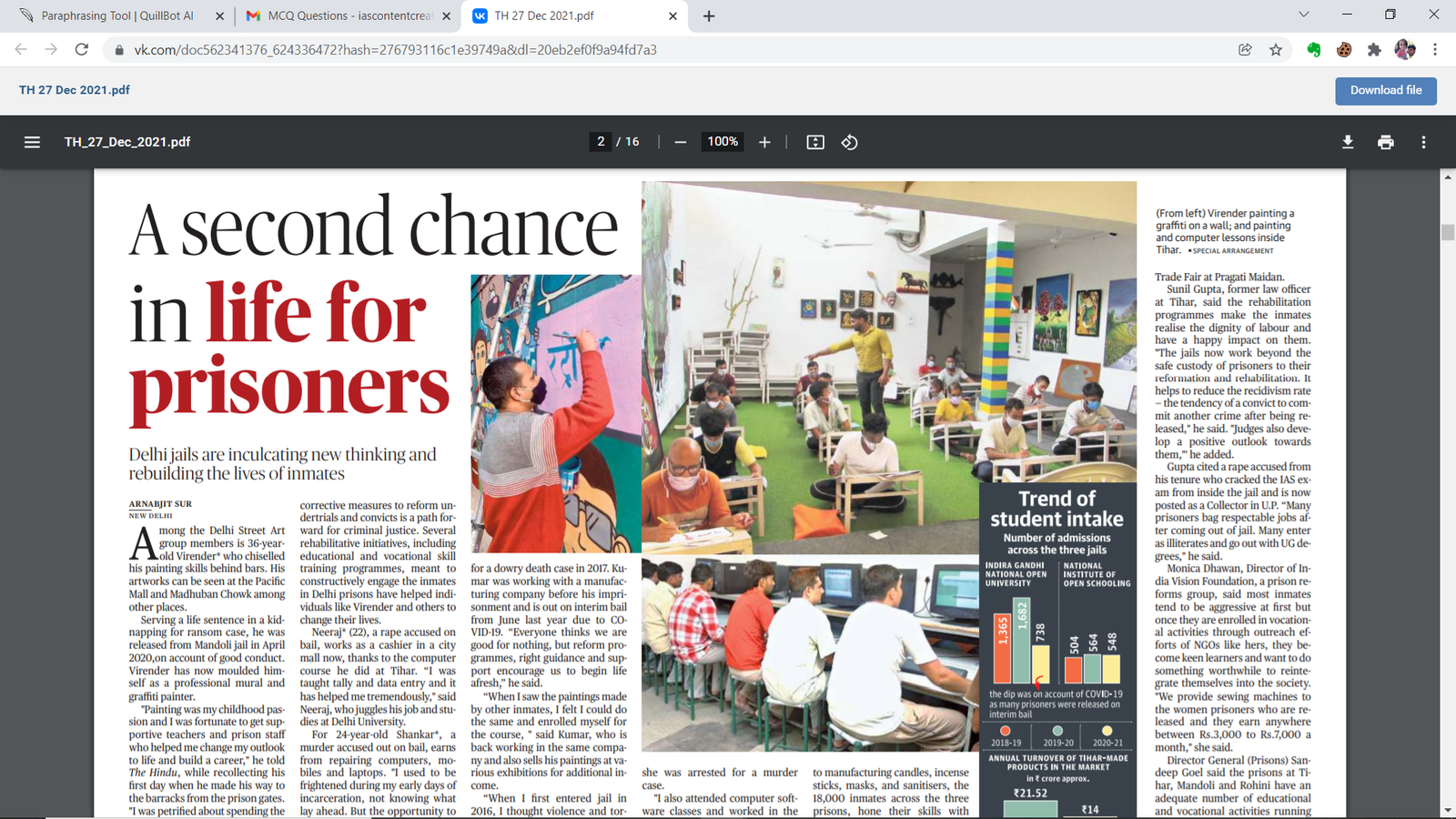
Prepare IAS Coaching
Current Affairs

Title : PRISON REFORMS
Date : Dec 28, 2021
Description :
Based on a News Article published in the ‘The Hindu’ on 27th December 2021 on Page Number 2
Useful for UPSC CSE Prelims and Mains (GS Paper II)
Background:
- During the second wave of COVID 19, the Indian Supreme Court (SC) ordered the interim release of eligible convicts.
- The Court's order aims to decongest jails while also protecting the convicts' right to life and health.
Points to Remember in the SC’s Order:
- The following are some of the most important aspects of the Supreme Court's decision:
- It emphasized the need of adhering to the rules it established in the Arnesh Kumar vs. State of Bihar (2014) decision.
- The police were advised not to make superfluous arrests in this case, especially in cases involving sentences of less than seven years in prison.
- Section 436A of the Code of Criminal Procedure will be implemented in all districts across the country (Cr.P.C).
- Under Section 436A of the Criminal Procedure Code, undertrials who have served half of the maximum sentence for the crime may be freed on personal bond.
- To minimize overcrowding in jails, the legislature should consider placing offenders under home arrest.
- In 2019, the prison occupancy rate increased to 118.5 percent.
- Furthermore, jail maintenance consumes a significant portion of the cash.
- All states were ordered to adopt preventative measures and form high-powered committees to assess which prisoners could be released on bail or parole for a set length of time.
Status of Prisons in India:
- Overcrowding, understaffing, and underfunding, as well as violent confrontations, are three long-standing structural restrictions in Indian jails.
- The National Crime Records Bureau (NCRB) published Prison Statistics India 2016 in 2019, which shows the plight of Indian prisoners.
Issues faced by Prisoners in India:
- Population in Pre-Trial Status:
- In 2016, India's under-trial population remained among the world's highest, with more than half of all undertrials being held for less than six months.
- According to the study, there were 4,33,033 inmates in prison at the end of 2016, with 68 percent of them awaiting trial.
- This shows that the high number of undertrials in the overall jail population may be due to wrongful arrests and inadequate legal representation during remand hearings.
- People in Preventive Detention: In Jammu and Kashmir, the number of people detained under administrative (or "prevention") detention legislation is on the rise.
- With 431 inmates in 2016, compared to 90 in 2015, there was a 300 percent rise.
- Authorities utilize administrative, or 'preventive,' custody to detain people without charge or trial, circumventing normal criminal justice procedures.
- Unawareness of C.R.P.C. Section 436A:
- Under Section 436A of the Code of Criminal Procedure, there is a discrepancy between the number of inmates eligible for release and those who are actually released.
- Only 929 of the 1,557 undertrials eligible for parole under Section 436A were freed in 2016.
- Furthermore, according to Amnesty India's study, prison staff are often unaware of this section and hesitant to enforce it.
- Unnatural Deaths in Prison:
- Between 2015 and 2016, the number of "unnatural" deaths in jails more than doubled, from 115 to 231.
- Suicide rates among inmates also climbed by 28%, from 77 suicides in 2015 to 102 suicides in 2016.
- According to the National Human Rights Commission (NHRC), a person is 1.5 times more likely to commit suicide in prison than they are outside. This could be a sign of the seriousness of mental health issues in Indian prisons.
- There aren't enough mental health professionals: In 2016, there was only one mental health expert for every 21,650 inmates, with psychologists/psychiatrists available in only six states and one union territory.
- In addition, the NCRB reported that 6,013 people with mental illnesses were in prison in 2016.
- According to the Prison Act of 1894 and the Prisoner Act of 1900, each jail should have a welfare officer and a law officer, but these officials have yet to be hired. This explains why prisons have received such a low political and budgetary priority in the previous century.
Reforms in Prisons Recommendations:
- The Justice Amitava Roy (retd.) Committee, which was established by the Supreme Court, has made the following suggestions for jail reform.
- In the event of overcrowding:
- Fast-paced trial: Rapid trial is still one of the most effective approaches to address the unjustified problem of overcrowding.
- Lawyer-to-Prisoner Ratio: There should be one lawyer for every 30 convicts, which is currently not the case.
- Courts of Appeal: Petty offenses that have been pending for more than five years should be dealt with in special fast-track courts.
- In addition, accused persons charged with minor offenses and granted bail but unable to secure surety should be released on a Personal Recognizance (PR) Bond.
- Avoid Adjournment: In cases when witnesses are present, an adjournment should not be allowed, and the concept of plea bargaining, in which the accused concedes guilt in exchange for a lighter punishment, should be advocated.
- For Detainees:
- To help him get through his first week in jail, every new prisoner should be permitted one free phone call every day to his family members.
- Legal Assistance: Providing competent legal assistance to inmates, as well as taking steps to provide vocational training and education to inmates.
- Use of ICT: For the trial, video conferencing was used.
- Alternatives: Instead of sending offenders to jail, the courts may be allowed to exercise their "discretionary powers" and award punishments such as "fine and admonition."
- Furthermore, in worthy circumstances, judges may be persuaded to release convicts on probation before or after trial.
- Filling Vacancies: The Supreme Court should issue orders directing authorities to begin the recruitment process for permanent positions within three months and to finish it within a year.
- For food, there are modern cooking facilities and canteens where needed products can be purchased.
- The Indian Law Commission proposed in 2017 that undertrials who have served a third of their maximum sentence for crimes punishable by up to seven years in jail be released on bail.
Provisions of the Constitution in this regard:
- Under Entry 4 of List II of the Seventh Schedule to the Constitution of India, 'prisons/persons incarcerated therein' is a State subject.
- State governments are responsible for the administration and management of prisons.
- The Ministry of Home Affairs, on the other hand, gives regular assistance and advice to States and UTs on a variety of topics relating to prisons and convicts.
- Article 39A of the Constitution Article 39A of the Constitution directs the state to ensure that the legal system operates in a way that promotes justice on an equal footing, and in particular, to provide free legal aid through appropriate legislation or schemes, or in any other way, to ensure that no citizen's right to justice is denied due to economic or other disabilities.
- The right to free legal assistance or free legal services is a fundamental right guaranteed by the United States Constitution.
- Under Article 21 of the Indian Constitution, "No individual shall be deprived of his life or personal liberty except pursuant to procedure provided by law," it serves as the foundation for reasonable, fair, and just liberty.
